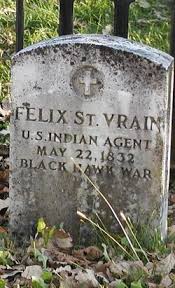Felix St. Vrain
| Felix St. Vrain | |
|---|---|
|
The grave of Felix St. Vrain. St. Vrain, was a United States Indian Agent and was killed, in an Indian attack, later known as the St. Vrain Massacre, during the Black Hawk War of 1832, the last Indian war in Illinois. | |
| Born |
Felix August Antoine St. Vrain March 23, 1799 St. Louis, Spanish Upper Louisiana Territory, present-day St. Louis, Missouri |
| Died |
May 24, 1832 (aged 33) Stephenson County, Illinois, near present-day Pearl City, Stephenson County, Illinois |
| Cause of death | gunshot wound in Indian attack |
| Resting place | Kellogg's Grove Cemetery, Kellogg's Grove, Stephenson County, Illinois |
| Nationality | American |
| Occupation | saw mill owner, sawyer, Indian agent |
| Employer | U.S. Government |
| Known for | Being a United States Indian Agent to the Sauk and Fox Tribes, who was killed in the Black Hawk War and was the brother of St. Louis fur trader, Ceran St. Vrain, who was the trading partner, of the Bent Brothers of, Bent's Fort, now La Junta, Otero County, Colorado |
| Spouse(s) | Marie Pauline Gregoire |
| Parent(s) | Jacques Marcellin Ceran de Hault de Lassus St. Vrain and Marie Felicite Dubreuil St. Vrain |
| Relatives | Ceran St. Vrain (brother), Savinien St. Vrain (brother), Marcellin St. Vrain (brother) Charles Emanuel St. Vrain (brother), Domitille St Vrain (brother), Emma De Hault Vrain (sister) |
Felix St. Vrain, born Felix August Antoine St. Vrain (March 23, 1799–May 24, 1832), was the brother of St. Louis fur trader, Ceran St. Vrain, who was the trading partner, of the Bent Brothers of, Bent's Fort, now La Junta, Otero County, Colorado, and a United States Indian agent who was killed during the Black Hawk War. St. Vrain died along with three companions while on a mission to deliver dispatches from Dixon's Ferry, Illinois to Fort Armstrong. The incident has become known as the St. Vrain massacre.
Early life
Felix St. Vrain was born in St. Louis, Missouri, a son of Jacques DeHault Delassus de St. Vrain.[1] He married Marie Pauline Gregoire in 1822, and eight years later settled in Kaskaskia, Illinois.[1] A sawmill operator in Kaskaskia, St. Vrain was 31 years old when he was appointed to replace Thomas Forsyth as an Indian agent.[2]
U.S. Indian agent
St. Vrain started working for the United States government as an Indian Agent in 1830.[1] He was assigned to the Sauk and Fox nations around Rock Island during William Clark's tenure as superintendent of the St. Louis Indian Agency.[1] St. Vrain's appointment came amidst Forsyth's ongoing criticism of William Clark.[2] St. Vrain had almost no experience dealing with Indians but being a member of a politically important St. Louis-French family he had connections to U.S. Senator Elias Kent Kane.[2] Kane was a close acquaintance of William Clark and recommended St. Vrain for the appointment.[2]

Black Hawk War and St. Vrain Massacre
When the Black Hawk War began, St. Vrain was stationed at Fort Armstrong. The story circulated upon his death by Governor John Reynolds was that St. Vrain was keenly in tune with Indian culture and was treacherously murdered by a chief who had adopted him as a brother Little Bear.[3] This story is almost certainly not true.[3]
While on a mission to deliver dispatches, from Dixon's Ferry, present-day Dixon, Illinois to Galena, under the command of General Henry Atkinson, Felix St. Vrain was killed, along with three other members of his party, on May 24, 1832, which came to be known later, as the "St. Vrain Massacre". The St. Vrain party were most likely attacked by a band of pro-Sauk Ho-Chunk warriors, though sources disagree over the attacker's tribe.[4][5][5]
St. Vrain and the other victims were buried by a detachment of soldiers under Colonel Henry Dodge.[5] One account of the massacre, from Gen. George W. Jones (St. Vrain's brother-in-law as well as the man who identified the body), claimed the attackers scalped all of the dead men, and cut off the hands, head and feet of St. Vrain. They then removed his heart, which they ate.[4] The victims' graves are located in Kellogg's Grove.[6] In 1834 (either January 6[1] or March 24[7]) the U.S. Congress passed a bill which provided relief for St. Vrain's family.[1] The Congressional relief was in the form a 640-acre land grant in the state of Missouri.[7]
See also
Notes
- 1 2 3 4 5 6 Delassus-St. Vrain Family Collection, (PDF), "Biographical Sketch," Missouri History Museum, p. 3. Retrieved 28 July 2007.
- 1 2 3 4 Trask, Kerry A., Black Hawk: The Battle for the Heart of America, (Google Books link), Macmillan, New York: 2007, p. 89.
- 1 2 Armstrong Perry A. The Sauks and the Black Hawk War (Google Books link) H.W. Rokker, printer, 1887 pp. 414-16.
- 1 2 Stevens, Frank E. The Black Hawk War, Frank E. Stevens 1903, pp. 169-171. Available online at Northern Illinois University Libraries Digitization Project.
- 1 2 3 "The Killing of Felix St. Vrain," Historic Diaries: Black Hawk War, Wisconsin Historical Society. Retrieved 28 July 2007.
- ↑ Dameier, Evelyn. "Kellogg's Grove Archived September 27, 2007, at the Wayback Machine.," (PDF), National Register of Historic Places Nomination Form, 18 January 1978, HAARGIS Database, Illinois Historic Preservation Agency. Retrieved 26 July 2007.
- 1 2 Britton Alexander Thompson. Laws of the United States of a Local or Temporary Character (Google Books link Government Printing Office, 1880 p. 436.
External links
- "William Clark papers" (Keyword search, St. Vrain) Kansas Historical Society accessed January 22, 2011.
